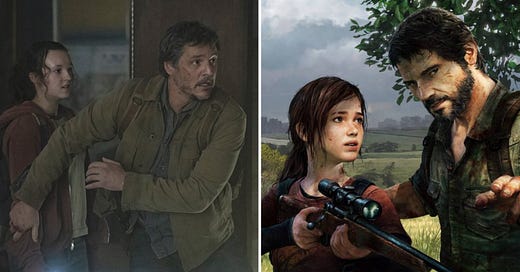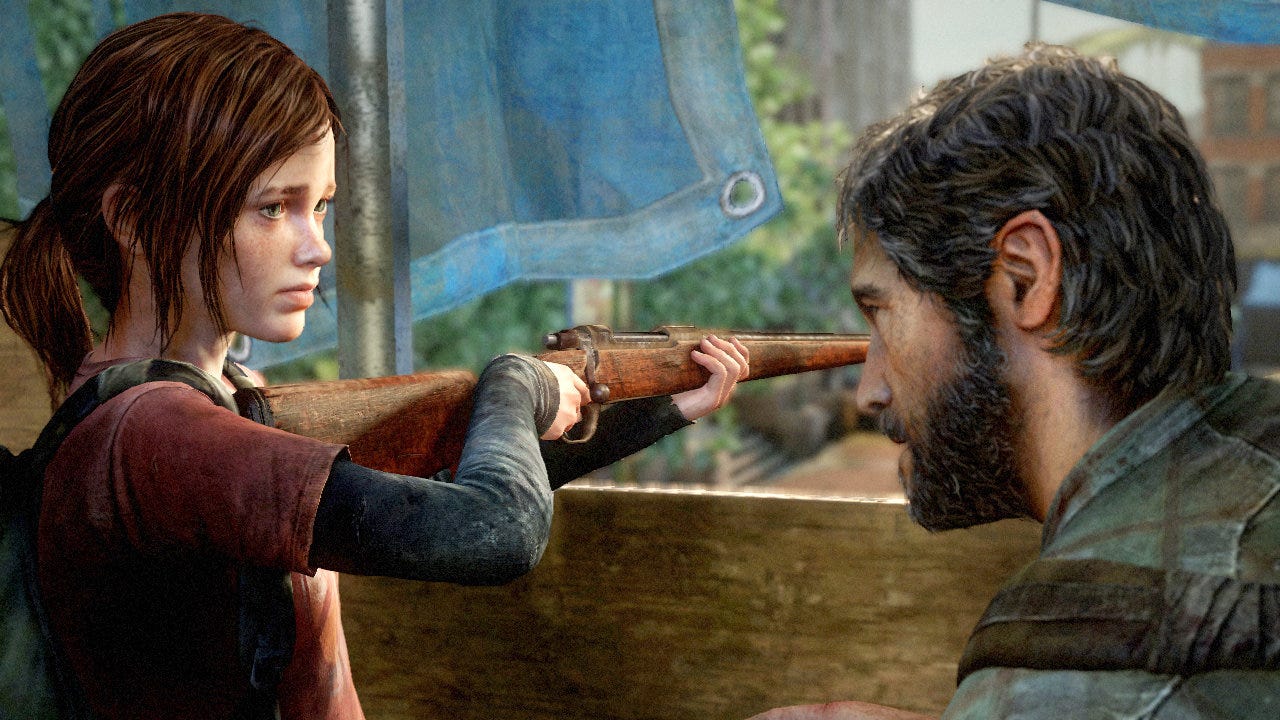Even when it was a Videogame, "The Last of Us" was a TV show
More thoughts on HBO's new hit zombie show and other game-to-movie (or in this case, TV show) adaptations.
So far, The Last of Us has been pretty damn good. I may have complained last week about the discourse surrounding the show (episode three is not the masterpiece everyone is hyping it up to be), but really, these are minor quibbles. Craig Mazin and Neil Druckmann have successfully transformed a renowned videogame into a television series. It has become a hit not just with videogame fans (though it is also that), but also with TV critics and mainstream audiences who have little to no interest in the gaming world.
A significant reason for the show’s success is that Mazin and Druckmann have adapted The Last of Us, the videogame, into The Last of Us, the TV show, without it feeling like a videogame. This is no small feat! Part of the problem with past videogame-to-movie (or TV show) adaptations has been a dependence upon the gut-punching action of videogames as their entertainment focal point. How, for example, might you adapt Max Payne—a videogame whose pleasure comes from shooting bad guys by diving through the air in slow motion—into a 90-minute movie? Well, by getting Mark Wahlberg to dive through the air and shoot bad guys in slow motion for 90 minutes. But of course that doesn’t work: Whatever story is in the film is shallow and gratuitous, lacking the cinematic punch that would keep audiences engaged.
Unlike videogames, films are a passive medium, meaning that it cannot depend purely upon action setpieces for its entertainment. Typically, the film-watching experience requires a higher emotional investment that is not necessarily the case in games. One could easily spend two hours shooting bad guys in a videogame because you are the one doing the shooting. When that “You” who was playing the game turns into some good-looking Bostonian who led the Funky Bunch, the appeal is lost.
Games depend on interaction; films depend on story. This is a very loose dichotomy that should in no way be taken as absolute. And yet, however incomplete, this dichotomy can also be helpful in explaining why The Last of Us has been such a success story—perhaps the only success story—in the turbulent world of videogame adaptations.
When it released in 2013, Naughty Dog’s The Last of Us (the videogame) received heaps of critical acclaim not just for its exceptional gameplay, but also for its exceptional storytelling. With characters and worldbuilding that could go toe-to-toe with the best that film and TV had to offer, The Last of Us came to be known as a touchstone for “cinematic” narrative experiences in videogames. This is not unusual in the gaming world. Videogames, especially higher-budget “triple-A” titles, have long tried to emulate cinematic storytelling techniques through the use of non-interactive cutscenes that, while separating you from actually playing the game, can allow for fantastic moments of performance and characterization. The Last of Us is in many ways the pinnacle of this “cinematic” ludonarrative philosophy, with complex characters, a compelling plot, and a starkly realized post-apocalyptic setting that quickly turned Naughty Dog’s zombie shooter into an instant classic. Gamers looking to prove merit in videogames everywhere held it up as an idol of artistry and achievement.
It’s easy to see why. Joel and Ellie were exceptional characters in a videogame industry that struggled to write them. Their journey across a zombiefied America is as sympathetic as it is gruesome, and remains thought-provoking all the while. Yet perhaps most impressive of all is the game’s sense of realism. The game’s writing was cohesive and intricate, its gameplay brutally honest in its horrific violence. With stellar motion-capture performances by Troy Baker and Ashley Johnson, The Last of Us was, in the words the inimitable Dunkey, “maybe the first videogame where people act and talk like people.”
So for those of you who have watched the show but not played the game: Yes, The Last of Us was this great to begin with.
This quality is part of what made The Last of Us primed for TV, but this doesn’t paint a full picture. Unlike many games, The Last of Us maintains a commitment to its narrative that is somewhat unique in the medium. Typically, gameplay takes precedence over story, as in the case of the aforementioned Max Payne (slo-mo shooting > neo-noir narrative). The same is not true in The Last of Us, where the aim is instead to make gameplay that serves its narrative. Here’s an even more unfair comparison: In a game like Super Mario Bros, where the objective is to get Mario to jump across platforms until he reaches the flag at the end of the level, a story can only serve so much purpose. A deep or emotionally compelling narrative would just distract from the running-and-jumping fun. (Really makes you wonder how that upcoming Chris Pratt-starring adaptation is going to go. My guess is Not Well.) The Last of Us, on the other hand, has gameplay that is designed not to service fun, but a larger story and theme.
The game’s commitment to story, while an undeniable success, nevertheless required certain sacrifices to gameplay. A good chunk of the game’s biggest narrative beats occur not during gameplay, but during cutscenes, where players sit passively and watch as one would in a movie. As a result, players can sometimes feel like they are playing less a videogame than occasionally interacting with a glorified movie. Indeed, some have made this argument, believing that The Last of Us is unsuccessful—or at least flawed—for its insistence on cinematic storytelling devices rather than interactive ones. While I don’t fully agree with these takes, they do highlight the game’s struggles to connect with its audience on an interactive level.
Funnily enough, it is precisely these non-interactive tendencies that make HBO’s The Last of Us such a perfect candidate for adaptation. Digitally controlling Joel and Ellie adds to our immersion in their world, to be sure, but let’s be honest: Most of our connection to them as characters came from watching them in cutscenes. This is in no way a criticism of the cutscenes themselves, which are written and rendered precisely and with palpable emotion. But as videogame adaptations go, The Last of Us was advantaged from the start.
So when critics start calling The Last of Us “the best videogame adaptation ever,” I can’t help but wonder how fair that statement really is. Of course it’s true. But when your points of comparison are one of the most emotionally compelling and cinematic videogames ever made vs. Max Payne and the Resident Evil series—why even compare?
This does some injustice to Mazin and Druckmann, who have done an exceptional job expanding The Last of Us into something that is almost completely unbound by the constraints of an interactive medium. For whatever complaints I leveled against the Ballad of Bill and Frank in last week’s post, I can’t deny that the show’s third episode deviates from the game’s original narrative in all the right ways, expanding the scope of The Last of Us’s storyworld in a uniquely episodic mode. But if ever there was a game to adapt into a cinematic medium, you may as well pick The Last of Us: a game that was already basically a TV show in itself.




